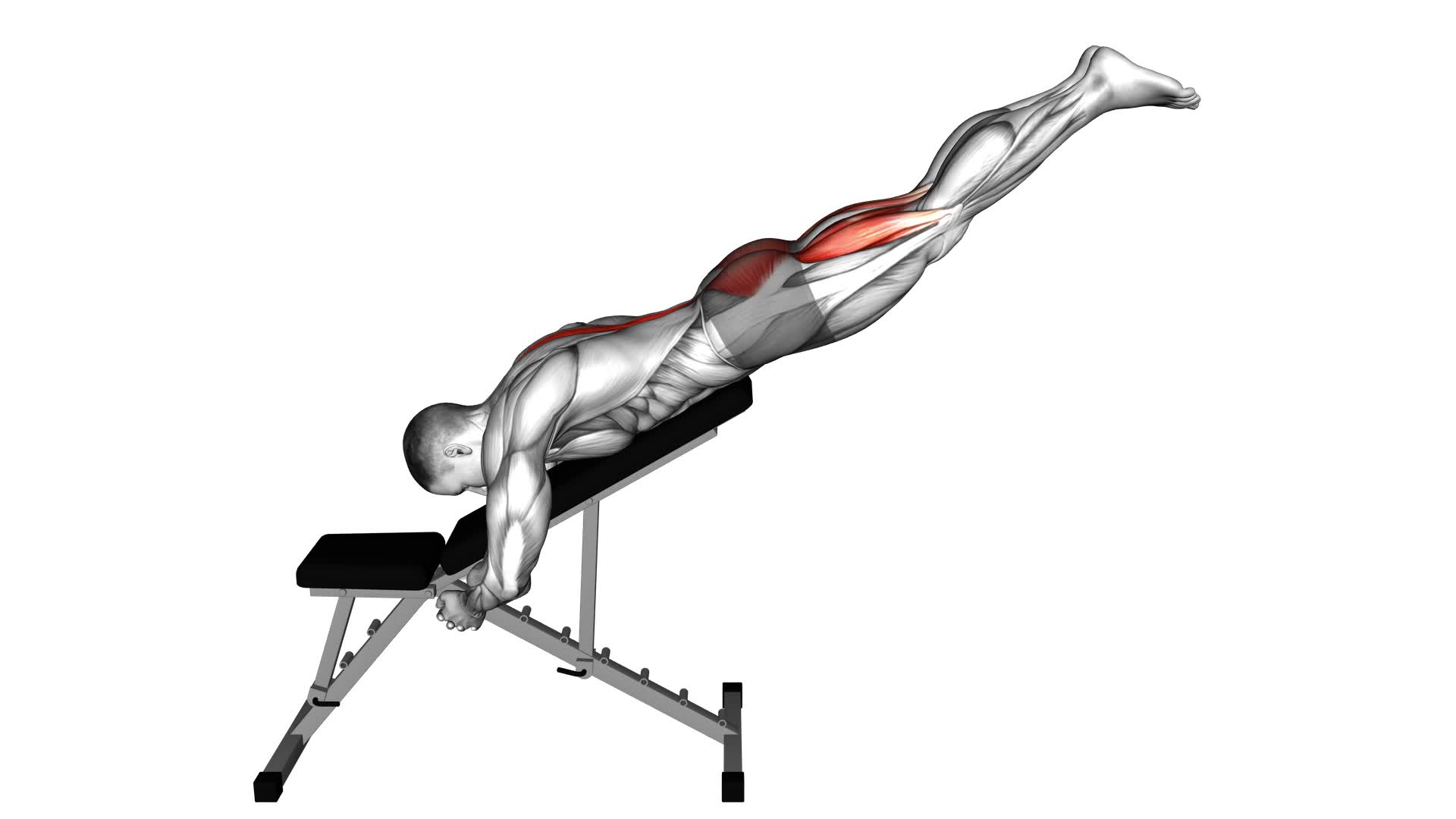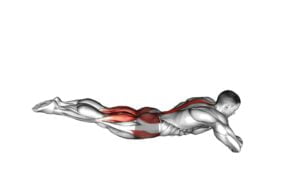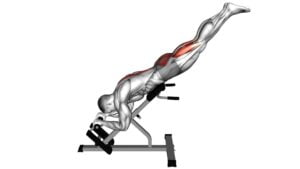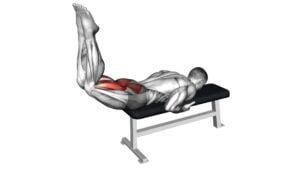Incline Reverse Hyperextension (male) – Video Exercise Guide & Tips

Are you looking to take your workout routine to the next level? Incline reverse hyperextension is the perfect exercise for you.
Watch This Exercise Video
This video exercise guide and tips will show you the benefits, proper form, and common mistakes to avoid.
With these tips, you'll be able to increase the difficulty and intensity of your workout.
Stay safe and get ready to see amazing results with incline reverse hyperextension.
Let's get started!
Key Takeaways
- The incline reverse hyperextension strengthens the lower back and glutes.
- It improves overall lower body strength and stability.
- The exercise reduces the risk of lower back pain and injuries.
- It targets and strengthens the muscles in the lower back while enhancing posture and stability.
Benefits of the Incline Reverse Hyperextension
The incline reverse hyperextension offers you numerous benefits for strengthening your lower back and glutes. This exercise is highly beneficial for individuals looking to improve their overall lower body strength and stability. One of the main benefits of the incline reverse hyperextension is its ability to target and strengthen the muscles in your lower back. By engaging these muscles, you can reduce the risk of developing lower back pain and injuries.
Additionally, this exercise also targets your glutes, helping to improve their strength and shape. Strong glutes aren't only important for aesthetic purposes but also for functional movements such as squatting and jumping. Engaging in the incline reverse hyperextension can also help improve your posture and stability, as it targets the muscles that support your spine.
Equipment and Setup for the Exercise
To properly set up for the incline reverse hyperextension exercise, you'll need essential equipment such as an adjustable incline bench and a hyperextension apparatus.
The video guide will demonstrate the proper technique for setting up the equipment and executing the exercise effectively.
Follow the instructions closely to ensure proper form and maximize the benefits of this exercise.
Essential Equipment for Setup
You will need a few essential pieces of equipment to properly set up for the Incline Reverse Hyperextension exercise. Here are the items you'll need:
- Adjustable incline bench: This will allow you to set the bench at the desired angle for the incline position, which enhances the benefits of the exercise.
- Reverse hyperextension machine: This machine is specifically designed for performing reverse hyperextensions and provides the necessary support and stability.
- Ankle straps: These straps will secure your ankles to the machine, ensuring proper alignment and preventing any unwanted movement.
- Weight plates: You can add weight plates to increase the intensity of the exercise as you progress and build strength.
- Safety clips: Use safety clips to secure the weight plates to the machine, preventing them from sliding off during the exercise.
Proper Technique Demonstration
To properly demonstrate the technique for the Incline Reverse Hyperextension exercise, you'll need to utilize the essential equipment and set up as discussed in the previous subtopic.
The Incline Reverse Hyperextension exercise is an effective way to target your lower back and improve overall back extension and lower back strength.
To perform this exercise, you'll need an incline reverse hyperextension machine. Adjust the machine to a comfortable and appropriate height for your body.
Lie face down on the machine with your hips resting on the pad and your upper body hanging off the edge. Position your feet securely under the footpads.
This setup will allow you to execute the exercise with proper form and technique, which will be discussed in the next section.
Proper Form and Technique
How can you ensure proper form and technique while performing the incline reverse hyperextension exercise? Follow these tips to maximize back strengthening and muscle activation:
- Start by adjusting the incline bench to a comfortable angle that allows your hips and upper body to align.
- Lie face down on the bench with your legs hanging off the edge and your feet secured.
Place your hands behind your head, keeping your elbows wide and your chest lifted.
- Engage your core muscles and squeeze your glutes as you lift your legs towards the ceiling.
- Focus on using your lower back muscles to control the movement, avoiding any excessive swinging or momentum.
To maintain proper form and technique, it's important to remember a few key points. Keep your neck in a neutral position throughout the exercise, avoiding any strain or tension. Maintain a slow and controlled pace, resisting the urge to rush through the movement. Lastly, listen to your body and adjust the weight or range of motion as needed to ensure proper form and prevent any discomfort or injury.
Common Mistakes to Avoid
When performing the incline reverse hyperextension, it's crucial to maintain proper form throughout the exercise.
This includes keeping your back supported and aligned, as well as avoiding excessive weight that could strain your lower back.
Proper Form Demonstration
To ensure proper form during the incline reverse hyperextension exercise, you must be cautious of common mistakes to avoid. Here are some tips to help you maintain correct technique and prevent injury:
- Avoid arching your back excessively: Keep your back in a neutral position throughout the movement to protect your spine.
- Don't use momentum: Use controlled and deliberate movements, focusing on engaging your lower back muscles.
- Don't lift your legs too high: Lift your legs until they're parallel to the ground, but avoid hyperextending your hips.
- Maintain a stable core: Engage your core muscles to provide stability and support for your lower back.
- Don't rush: Take your time and perform the exercise with proper form, rather than rushing through it.
Importance of Back Support
To maintain proper form and prevent injury during the incline reverse hyperextension exercise, it's crucial for you to provide adequate support to your back. Back strengthening is essential for overall fitness and injury prevention. When performing the incline reverse hyperextension, make sure to engage your core and keep your back in a neutral position. Avoid arching or rounding your back, as this can put excessive strain on your spine and increase the risk of injury.
It's important to use proper back support, such as a weightlifting belt or back brace, to stabilize your spine during the exercise. By providing adequate support to your back, you can ensure proper alignment and reduce the risk of injury.
Now, let's move on to the next section and discuss the importance of avoiding excessive weight.
Avoiding Excessive Weight
To prevent injury and maintain proper form, avoid using excessive weight during the incline reverse hyperextension exercise. Proper weight management is essential for injury prevention and maximizing the benefits of this exercise.
Here are some common mistakes to avoid:
- Start with a weight that allows you to maintain control and proper form throughout the movement.
- Gradually increase the weight as your strength and stability improve.
- Avoid using momentum or jerking motions to move the weight, as this can strain your lower back and increase the risk of injury.
- Focus on engaging your glutes and hamstrings while performing the exercise, rather than solely relying on the weight.
- Listen to your body and stop if you experience any pain or discomfort.
By avoiding excessive weight and focusing on proper form, you can reduce the risk of injury and ensure effective weight management.
Now, let's move on to some tips for increasing difficulty and intensity.
Tips for Increasing Difficulty and Intensity
Increase the difficulty and intensity of the Incline Reverse Hyperextension exercise by adding weight to your ankles. By increasing resistance, you can challenge your lower back, glutes, and hamstrings even more effectively. Start by using ankle weights or attaching dumbbells to your ankles. Begin with a lighter weight and gradually increase the load as you become more comfortable and stronger. This will help you progress and achieve better results.
To further advance the exercise, you can try different variations. One option is to perform the exercise on a decline bench instead of an incline bench. This will increase the range of motion and engage your muscles differently. Another option is to hold a weight plate against your chest while performing the exercise. This will add additional resistance to your upper body, making the exercise more challenging.
Safety Precautions and Modifications
To ensure safe and effective execution of the Incline Reverse Hyperextension exercise, it's important to be aware of safety precautions and modifications that can be implemented. Here are some key points to keep in mind:
- Maintain proper form: It's crucial to maintain a neutral spine throughout the exercise. Avoid hyperextending or rounding your back, as this can increase the risk of injury.
- Start with lighter weights: If you're new to this exercise, start with lighter weights to allow your body to adapt and gradually increase the load over time.
- Use a spotter: If you're using heavy weights or pushing yourself to failure, it's recommended to have a spotter present to assist you and ensure your safety.
- Listen to your body: Pay attention to any pain or discomfort during the exercise. If you experience any sharp or intense pain, stop immediately and consult with a healthcare professional.
- Alternative exercises: If you have a history of back injuries or if the Incline Reverse Hyperextension causes discomfort, there are alternative exercises that can target the same muscle groups. Some alternatives include glute bridges, back extensions, or bird dogs.
Frequently Asked Questions
What Are Some Alternative Exercises That Can Target the Same Muscle Groups as the Incline Reverse Hyperextension?
If you're looking for alternative exercises to target the same muscle groups as the incline reverse hyperextension, there are a few options you can try. These exercises can provide similar benefits to the incline reverse hyperextension, such as strengthening the lower back and glutes.
Some alternatives include the glute bridge, back extensions, and supermans. Incorporating these exercises into your routine can help diversify your workout and target those muscle groups effectively.
Can the Incline Reverse Hyperextension Be Performed by Individuals With Lower Back Injuries or Conditions?
If you have lower back injuries or conditions, it's important to be cautious when performing exercises. When considering the incline reverse hyperextension, it's best to consult with a healthcare professional to determine if it's suitable for you.
There are alternative exercises that can target the same muscle groups without putting strain on your lower back.
It's essential to prioritize your safety and find exercises that promote overall back health.
How Often Should the Incline Reverse Hyperextension Be Incorporated Into a Workout Routine for Optimal Results?
To incorporate the incline reverse hyperextension into your workout routine for optimal results, it's important to do it consistently.
The incline reverse hyperextension is a great exercise for strengthening your lower back and glutes.
Aim to perform it at least two to three times a week.
Start with a weight that challenges you but allows for proper form. Gradually increase the weight as you get stronger.
Remember to always listen to your body and consult with a professional if you have any concerns.
Are There Any Specific Breathing Techniques That Should Be Used During the Incline Reverse Hyperextension?
During the incline reverse hyperextension, it's important to focus on your breathing technique. By exhaling as you lift your legs and inhaling as you lower them, you can engage your core muscles more effectively.
This controlled breathing helps to stabilize your body and maximize the benefits of the exercise for core strength.
Practicing proper breathing techniques during the incline reverse hyperextension will enhance your overall workout and help you achieve optimal results.
Can the Incline Reverse Hyperextension Help Improve Posture and Alleviate Lower Back Pain?
Yes, the incline reverse hyperextension can indeed help improve your posture and alleviate lower back pain.
By targeting the muscles in your lower back and core, this exercise strengthens and stabilizes your spine, leading to better posture and reduced discomfort.
Incorporating the incline reverse hyperextension into your fitness routine can provide long-term benefits for your overall spinal health and help you maintain a strong and pain-free lower back.
Conclusion
The incline reverse hyperextension is a beneficial exercise that targets the lower back and glutes. By using the proper equipment and maintaining proper form and technique, you can maximize the benefits of this exercise while avoiding common mistakes.
To increase the difficulty and intensity, you can adjust the incline or add resistance. It's important to prioritize safety by following proper precautions and modifications.
Incorporate the incline reverse hyperextension into your workout routine for a stronger and more stable lower body.

Author
Years ago, the spark of my life’s passion ignited in my mind the moment I stepped into the local gym for the first time. The inaugural bead of perspiration, the initial endeavor, the very first surge of endorphins, and a sense of pride that washed over me post-workout marked the beginning of my deep-seated interest in strength sports, fitness, and sports nutrition. This very curiosity blossomed rapidly into a profound fascination, propelling me to earn a Master’s degree in Physical Education from the Academy of Physical Education in Krakow, followed by a Sports Manager diploma from the Jagiellonian University. My journey of growth led me to gain more specialized qualifications, such as being a certified personal trainer with a focus on sports dietetics, a lifeguard, and an instructor for wellness and corrective gymnastics. Theoretical knowledge paired seamlessly with practical experience, reinforcing my belief that the transformation of individuals under my guidance was also a reflection of my personal growth. This belief holds true even today. Each day, I strive to push the boundaries and explore new realms. These realms gently elevate me to greater heights. The unique combination of passion for my field and the continuous quest for growth fuels my drive to break new ground.







